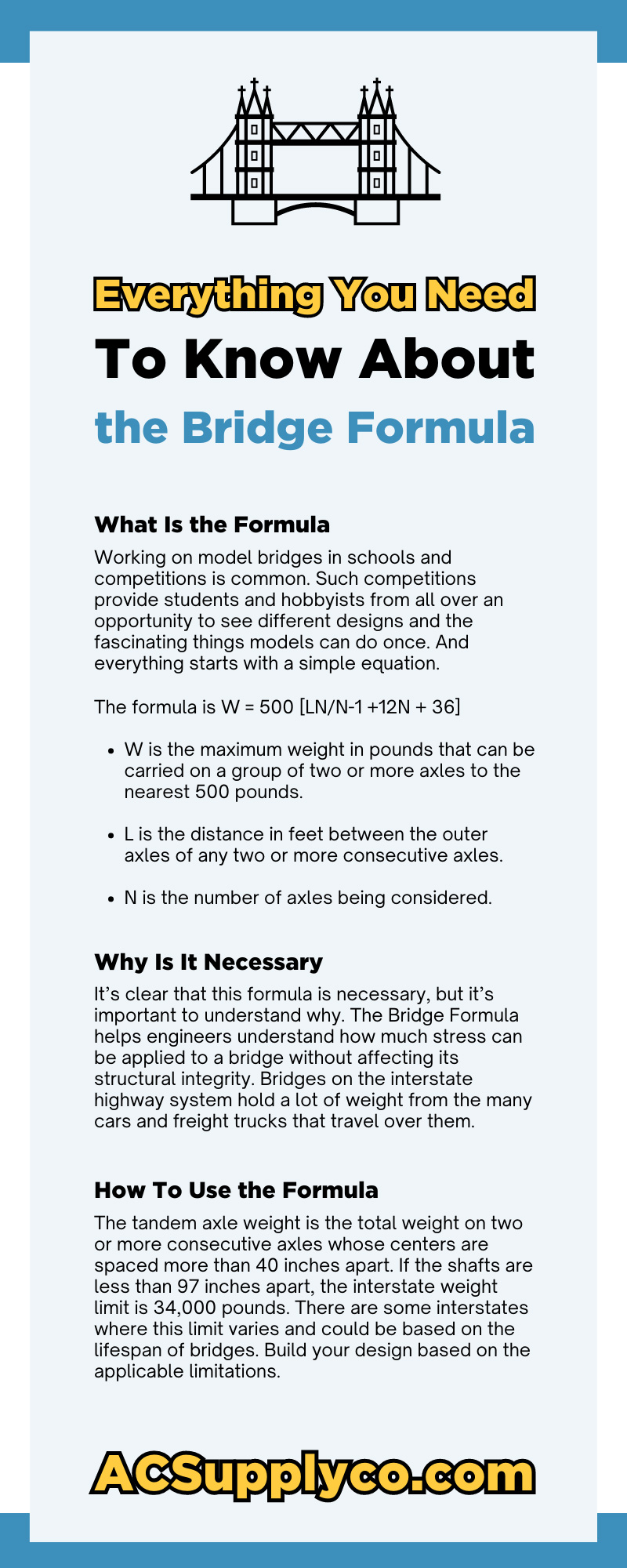It’s safe to assume all bridges start as a model first before they become life-size. Engineers and construction workers need something to reference and replicate. But before they can even attempt to construct a model, they need to do a little math and science first. There are always specific calculations involved when working with something this complex. Here’s everything you need to know about the bridge formula.
What Is the Formula
Working on model bridges in schools and competitions is common. Such competitions provide students and hobbyists from all over an opportunity to see different designs and the fascinating things models can do once. And everything starts with a simple equation.
Well, it may not be entirely simple, but it does form the building blocks for a more complicated process. Congress enacted the Bridge Formula in 1975 to limit the weight-to-length ratio of a vehicle crossing a bridge. You can either calculate this ratio by spreading weight over additional axles or by increasing the distance between axles.
The formula is W = 500 [LN/N-1 +12N + 36]
- W is the maximum weight in pounds that can be carried on a group of two or more axles to the nearest 500 pounds.
- L is the distance in feet between the outer axles of any two or more consecutive axles.
- N is the number of axles being considered.
Aside from Bridge Formula weight limits, federal law states that single axles are limited to 20,000 pounds, and axles spaced between 40 inches and 96 inches apart (tandem axles) are limited to 34,000 pounds. Gross vehicle weight is limited to 80,000 pounds.
Why Is It Necessary
It’s clear that this formula is necessary, but it’s important to understand why. The Bridge Formula helps engineers understand how much stress can be applied to a bridge without affecting its structural integrity. Bridges on the interstate highway system hold a lot of weight from the many cars and freight trucks that travel over them.
Additionally, vehicles have only gotten heavier over time, which is something engineers need to consider when designing bridges. New advancements in technology mean vehicles come with more devices and features, which contribute to their overall weight. This is especially true of trucks. Between the ‘50s and ‘60s, trucks became heavier, and their designs became more spread out.
Manufacturers now design trucks to hold more, and when the weight is spread out across a longer distance, the force applied to the bridge is lower. A smaller truck with the same amount of weight causes more pressure on the bridge, which will reduce its lifespan. Congress mandated the federal bridge law for this very reason—to save bridges across the country from destruction.
How To Use the Formula
Understand that the formula takes three variables into account: tandem axle weight, single axle weight, and gross vehicle weight.
The vehicle’s gross weight is the total weight of the cargo, trailer, and truck. Keep in mind the federal government limited a vehicle’s gross weight to 80,000 pounds. The single-axle weight refers to the total weight of one or more axles. Engineers need to space out the center axles no more than 40 inches apart. Axle weights spread more than 40 inches have a weight limit of 20,000 pounds, the same as the federal single-axle weight.
The tandem axle weight is the total weight on two or more consecutive axles whose centers are spaced more than 40 inches apart. If the shafts are less than 97 inches apart, the interstate weight limit is 34,000 pounds. There are some interstates where this limit varies and could be based on the lifespan of bridges. Build your design based on the applicable limitations.
How To Find the Correct Weight
Finding the correct weight is typically a clear-cut process. It might take a little trial and error, but that’s the beauty of the formula. The formula will find the limitations you need to adhere to before you begin constructing and designing anything.
Do not deviate from the axle limitations. Each one of them is in place to ensure the safety and success of the bridges and cargo. As previously stated, a single-axle weight limit is no more than 40 inches apart, and the tandem axle weight limit is no more than 96 inches apart. Thus, if you set the restrictions at 97 inches apart, two axles can carry 38,000 pounds, and three axles can carry 42,000 pounds.
What Can Poor Balance Lead To
It’s safe to say a poorly balanced bridge could have catastrophic consequences. Improper weight balance can make operating commercial vehicles dangerous. Not everything is foolproof. There could be a moment when the weight distributed inside the truck is uneven. In situations like this, the bridge needs to act as a safety net.
For example, piling cargo too high on a truck bed raises the vehicle’s center of gravity. If the gravity is too high, the vehicle is more likely to tip over. The formula of the bridge can help even out the imbalance and prevent accidents from occurring. Cargo that has too much weight on one side can also have damaging effects if the vehicle’s axles didn’t follow the formula.
These situations aren’t necessarily common because truck drivers know to follow guidelines for safely transporting cargo. They must load cargo as compactly as possible, with the heaviest items on the bottom and evenly distributed between the axles.
Work With Us
At AC Supply, we love the complexities that go into constructing and building a bridge. We especially love the beginning stages of the process. That’s why our bridge-building kits are advanced enough that teachers can use them to instruct their students in most STEM classes. They’re complicated enough to entice and engage students of all ages.
Students can go from learning about the formula to constructing a bridge all on their own. Of course, this design will be equipped to hold a pile of pennies or even a model toy truck for better effect. Without the formula as a guiding tool, students might build a bridge that buckles under the first sign of pressure.
Teach them everything they need to know about the bridge formula, then shop with us for kits that will start your students off right!



